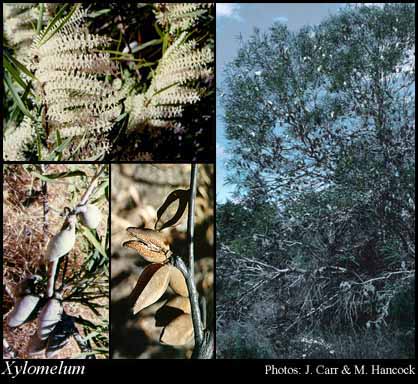- Reference
- Trans.Linn.Soc.London,Bot. 4:214 (1798)
- Name Status
- Current

Scientific Description
Common name. Woody Pear. Family Proteaceae.
Habit and leaf form. Tall shrubs, or trees; evergreen. To 4–14 m high. Mesophytic, or xerophytic. Heterophyllous. Leaves medium-sized to large; opposite; leathery; petiolate; edgewise to the stem, or with ‘normal’ orientation; simple; epulvinate. Leaf blades dissected (variously lobed), or entire; flat; linear, or ovate, or obovate, or elliptic; pinnately veined. Leaves without stipules. Leaf blade margins entire, or dentate (and prickly). Leaves without a persistent basal meristem. Stem anatomy. Secondary thickening developing from a conventional cambial ring.
Reproductive type, pollination. Fertile flowers hermaphrodite. Unisexual flowers absent. Plants hermaphrodite. Entomophilous.
Inflorescence and flower features. Flowers aggregated in ‘inflorescences’. Inflorescence many-flowered. Flowers in pairs, subtended by a common bract; in spikes. Inflorescences axillary, or terminal (in some species becoming lateral as the stem elongates); the conflorescence a leafy raceme of axillary spikes or robust, densely-flowered, terminal and paniculately-branched; with involucral bracts. Involucral bracts persistent, or deciduous. The fruiting inflorescence not conelike. Flowers sessile; bracteate, or ebracteate. Bracts persistent, or deciduous. Flowers small to medium-sized; regular; 4 merous; cyclic; tetracyclic. Floral receptacle developing a gynophore, or with neither androphore nor gynophore. Free hypanthium absent. Hypogynous disk present; extrastaminal; of separate members (comprising 4 small, more or less oblong glands). Perianth of ‘tepals’; 4; 1 -whorled; joined (straight, tepals becoming revolute at anthesis); hairy; white to cream, or yellow. Androecial members definite in number. Androecium 4. Androecial members adnate; all equal; free of one another; 1 -whorled. Stamens 4; isomerous with the perianth. Anthers basifixed; non-versatile; dehiscing via longitudinal slits; introrse; four locular; tetrasporangiate. Gynoecium 1 carpelled. The pistil 1 celled. Gynoecium monomerous; of one carpel; superior. Carpel stylate; apically stigmatic. Style pollen presenter ellipsoidal, clavate or cucullate. Carpel 2 ovuled. Placentation marginal, or apical. Ovary shortly stipitate, or subsessile, or sessile. Ovules horizontal; non-arillate; anatropous.
Fruit and seed features. Fruit persistent; non-fleshy; hairy, or not hairy. The fruiting carpel tardily dehiscent (along the adaxial surface or by 2 valves); a follicle (‘pear-shaped’). Follicles without septa. Fruit 2 seeded. Seeds non-endospermic; compressed; winged. Seed wings not encircling body (wing terminal). Embryo well differentiated. Cotyledons 2(–8). Embryo straight.
Special features. Stamens inserted within a concavity near the end of a perianth segment.
Geography, cytology, number of species. Native of Australia. Endemic to Australia. Australian states and territories: Western Australia, Queensland, and New South Wales. South-West Botanical Province. N=14.
Etymology. From the Greek for "wood" and "apple, fruit generally"; refers to the woody, pear-shaped nuts.